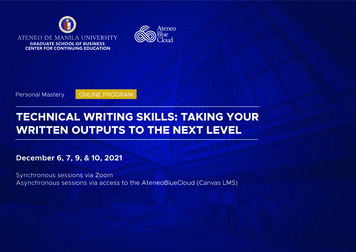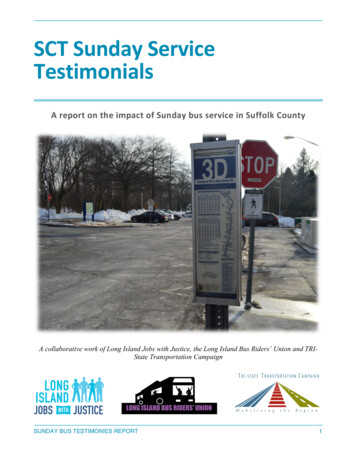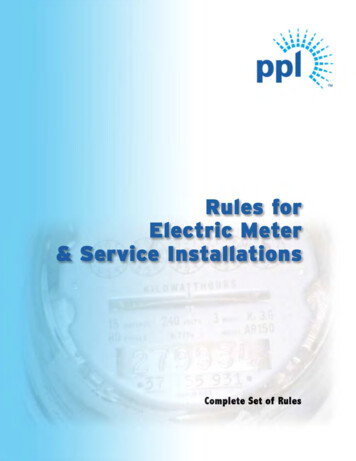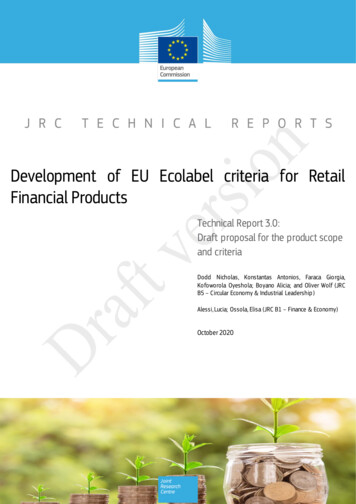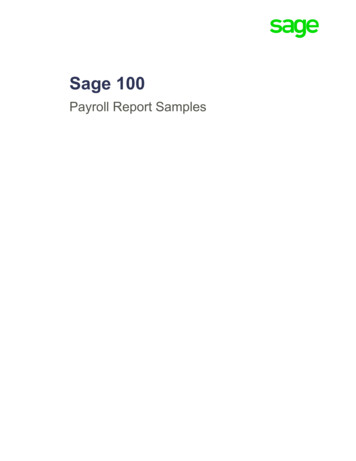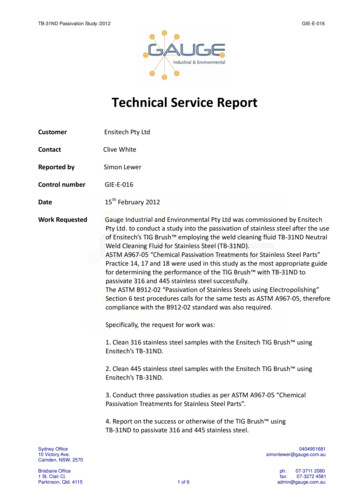
Transcription
TB-31ND Passivation Study /2012GIE-E-016Technical Service ReportCustomerEnsitech Pty LtdContactClive WhiteReported bySimon LewerControl numberGIE‐E‐016Date15th February 2012Work RequestedGauge Industrial and Environmental Pty Ltd was commissioned by EnsitechPty Ltd. to conduct a study into the passivation of stainless steel after the useof Ensitech’s TIG Brush employing the weld cleaning fluid TB‐31ND NeutralWeld Cleaning Fluid for Stainless Steel (TB‐31ND).ASTM A967‐05 “Chemical Passivation Treatments for Stainless Steel Parts”Practice 14, 17 and 18 were used in this study as the most appropriate guidefor determining the performance of the TIG Brush with TB‐31ND topassivate 316 and 445 stainless steel successfully.The ASTM B912‐02 “Passivation of Stainless Steels using Electropolishing”Section 6 test procedures calls for the same tests as ASTM A967‐05, thereforecompliance with the B912‐02 standard was also required.Specifically, the request for work was:1. Clean 316 stainless steel samples with the Ensitech TIG Brush usingEnsitech’s TB‐31ND.2. Clean 445 stainless steel samples with the Ensitech TIG Brush usingEnsitech’s TB‐31ND.3. Conduct three passivation studies as per ASTM A967‐05 “ChemicalPassivation Treatments for Stainless Steel Parts”.4. Report on the success or otherwise of the TIG Brush usingTB‐31ND to passivate 316 and 445 stainless steel.Sydney Office10 Victory Ave.Camden, NSW, 25700404951681simonlewer@gauge.com.auBrisbane Office1 St. Clair Cl.Parkinson, Qld. 4115ph:07-3711 2080fax:07-3272 4581admin@gauge.com.au1 of 6
TB-31ND Passivation Study /2012MethodGIE-E-0161. A TIG Brush was used throughout this study as per manufacturer’s instructionproviding 13 volts alternating current*.2. The method of cleaning was as per Ensitech’s instruction which includedsaturating the tip with the TB‐31ND and contacting the tip of the brush on thearea to be cleaned.3. TB‐25 Weld Cleaning Fluid for Stainless Steel (TB‐25) was used as a positivecontrol in this study based on its passivation performance in the GIE‐E‐012passivation study. TB‐25 was used in the same way as TB‐31ND in cleaning thesample. A new brush was used for the TB‐25 cleaning.4. To eliminate contamination, the brush for each chemical was triple rinsed indeionised water between each sample.4. The batches of TB‐31ND and TB‐25 fluids were both manufactured in February2012. The chemicals were samples of production batches.5. Samples of 316 and 445 stainless steel were supplied by Ensitech. The weldedsamples were TIG welded.6. Both welded and unwelded samples were treated and subsequently tested.7. All treatments were performed in triplicate.8. Both 316 and 445 stainless steel were tested for passivation as per ASTM A967‐05 Practice A – Water Immersion Test.9. 316 samples were tested for passivation as per ASTM A967‐05 Practice E‐Potassium ferricyanide‐nitric acid test. The method was followed including themaking of the Potassium ferricyanide‐nitric acid solution on the day of testing.A ferrous sulphate spike was added to a blank piece of 316 stainless steel acting asa positive control.10. 445 samples were tested for passivation as per ASTM A967‐05 Practice D‐Copper Sulphate Test.* The electrical offer can be achieved using any of the following TIG Brush modelsand settings:TB‐250 setting “3B”TBX‐150 / TBE‐150 setting “Clean” outputTBX‐300 / TBE‐250 setting "High Power / Clean Mode"TBE‐700 setting "Low Power / Clean Mode"Sydney Office10 Victory Ave.Camden, NSW, 25700404951681simonlewer@gauge.com.auBrisbane Office1 St. Clair Cl.Parkinson, Qld. 4115ph:07-3711 2080fax:07-3272 4581admin@gauge.com.au2 of 6
TB-31ND Passivation Study DTB‐25TotalPotassium ferricyanide‐nitric acid33333318Copper Sulphate33333318Water Immersion33333318Water Immersion33333318Table 1: Sample Type and Numbers of ��31NDTB‐25Water Immersion‐,‐,‐‐,‐,‐‐,‐,‐ , , ‐,‐,‐‐,‐,‐Potassium ferricyanide‐nitric acid‐,‐,‐‐,‐,‐‐,‐,‐ , , �31NDTB‐25Water Immersion‐,‐,‐‐,‐,‐‐,‐,‐ , , ‐,‐,‐‐,‐,‐Copper sulphate‐,‐,‐‐,‐,‐‐,‐,‐ , , ‐,‐,‐‐,‐,‐Table 2: Results of Passivation Testing (triplicates)Key: ‐ no reaction/no sign of corrosion or staining a reaction /positive observation of corrosion or stainingNumber of indicates degree of corrosion or staining (where is highand is low)Note: The ferrous sulphate spike on 316 tested positive in potassium ferricyanide‐nitricacid test indicating efficacy of the test solution.Sydney Office10 Victory Ave.Camden, NSW, 25700404951681simonlewer@gauge.com.auBrisbane Office1 St. Clair Cl.Parkinson, Qld. 4115ph:07-3711 2080fax:07-3272 4581admin@gauge.com.au3 of 6
TB-31ND Passivation Study /2012GIE-E-016Test Sample ImagesFigure 1: 316 samples: Potassium Ferricyanide – Nitric Acid TestNote the blue staining in the centre image of an uncleaned sample indicating free iron.Note no blue staining in the right image of a sample cleaned using the TIG Brush withTB‐31ND.Figure 2: 445 samples: Copper Sulphate test.Note the copper colouration arrowed on the uncleaned weld sample compared to nocopper colouration on the sample cleaned with the TIG Brush using TB‐31ND.Sydney Office10 Victory Ave.Camden, NSW, 25700404951681simonlewer@gauge.com.auBrisbane Office1 St. Clair Cl.Parkinson, Qld. 4115ph:07-3711 2080fax:07-3272 4581admin@gauge.com.au4 of 6
TB-31ND Passivation Study /2012GIE-E-016Figure 3: 445 samples: Water Immersion TestNote the rust colouration arrowed on the uncleaned weld sample compared to no rustcoloration on the sample cleaned with the TIG Brush using TB‐31ND.Description of Results All unwelded samples showed NO evidence of corrosion or staining in any test. Thiswas true for unwelded samples uncleaned or cleaned with the TIG Brush . This wasan expected result since the passive chromium oxide layer had not been disrupted bywelding. Welding of the 316 samples compromised their ability to resist corrosion. This wasshown by signs of corrosion in the water immersion test and also strong positives forfree iron in the Potassium ferricyanide‐nitric acid test. Welding of the 445 samples compromised their ability to resist corrosion. This wasshown by signs of corrosion in the water immersion test and also strong positives forfree iron in the Copper Sulphate test. All welded 316 samples cleaned with the TIG Brush using TB‐31ND showed no signsof corrosion in the water immersion test and negative results for free iron in thePotassium ferricyanide‐nitric acid test. All welded 445 samples cleaned with the TIG Brush using TB‐31ND showed no signsof corrosion in the water immersion test and negative results for free iron in theCopper sulphate test. All welded samples cleaned with TB‐25 showed negative results in Water Immersion,Potassium ferricyanide – nitric acid and Copper sulphate tests indicating passivationcompliant with ASTM A967‐05 and consistent with results found in the 2010 GIE‐E‐012 passivation study.Sydney Office10 Victory Ave.Camden, NSW, 25700404951681simonlewer@gauge.com.auBrisbane Office1 St. Clair Cl.Parkinson, Qld. 4115ph:07-3711 2080fax:07-3272 4581admin@gauge.com.au5 of 6
TB-31ND Passivation Study /2012GIE-E-016Interpretation and ConclusionsWelding of stainless steel is an operation that reduces the material’s ability to resist corrosion. This isdue to the disruption of the passivating dense chromium oxide layer and creation of a surface oxidelayer which contains iron and is not resistant to oxygen penetration which allows the continuingcorrosion of the weld. The removal of iron in the surface layer allows the dense chromium layer tore‐establish which passivates the weld and returns the material to an equivalent corrosion resistanceto that of unwelded stainless steel.This study determined that the use of the TIG Brush as per Ensitech’s use recommendations withTB‐31ND fluid provides effective passivation of both 316 and 445 stainless steels compliant viathree standard methods of ASTM A967‐05 “Chemical Passivation Treatments for Stainless SteelParts, as well as complying with ASTM B912‐02 “Passivation of Stainless Steels usingElectropolishing” Section 6.References:ASTM A967‐05 “Chemical Passivation Treatments for Stainless Steel Parts; ASTM InternationalASTM B912‐02 “Passivation of Stainless Steels using Electropolishing”; ASTM InternationalTechnical Guidelines on TIG Brush use for cleaning stainless steel. Ensitech Pty Ltd.END OF DOCUMENTSydney Office10 Victory Ave.Camden, NSW, 25700404951681simonlewer@gauge.com.auBrisbane Office1 St. Clair Cl.Parkinson, Qld. 4115ph:07-3711 2080fax:07-3272 4581admin@gauge.com.au6 of 6
The ASTM B912‐02 “Passivation of Stainless Steels using Electropolishing” Section 6 test procedures calls for the same tests as ASTM A967‐05, therefore compliance with the B912‐02 standard was also required. Specifically, the request for work was: 1. Clean 316 stainless steel samples with the Ensitech TIG Brush using



